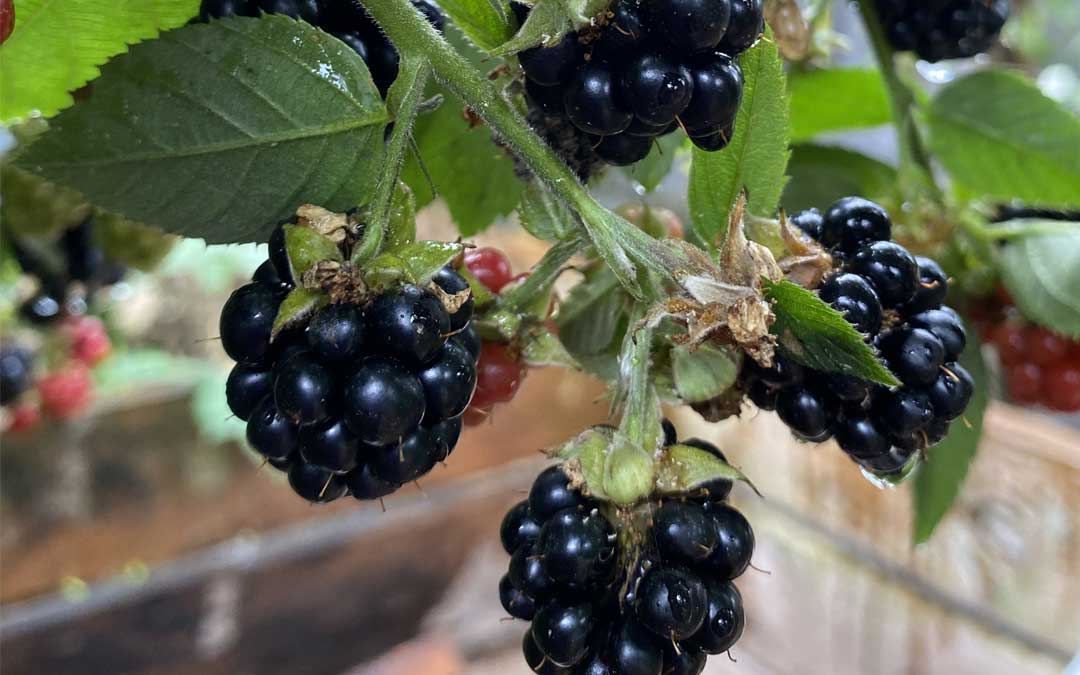The joy of thornless berries

Do you love berries but groan at the price, despair at how quickly they can become mouldy and dislike being pricked as you harvest them? The answer may be to grow a thornless variety – you’ll have an abundance of berries at no cost and harvesting them will be a joy (and pain-free). Thornless berries are very easy to cultivate, non-invasive, self-pollinating and frost-hardy.
Some years ago I planted a thornless loganberry and a thornless blackberry. Each year in November and December my family enjoy a glut of juicy, delicious loganberries, and after Christmas, the blackberry provides us with plump, sweet, juicy berries for several months. I find one plant of each is plenty. I’ve planted one at each end of an espalier, using the espalier poles to support them, and this has saved space and the effort of erecting a trellis. Thornless varieties are said to be less vigorous than thorned ones, and while this is true, the vigour is exceptional and just right for the home garden.
Thornless varieties are semi-upright, growing tall from a contained clump. They need a strong trellis to support their heavy canes or they can be trained along horizontal wires. Tie the canes on as they will not attach by themselves. Laterals (side shoots) can be pruned back or left to run if you have the space to provide some horizontal wire(s) for them to snake along. I’ve attached some wires between one espalier pole and the fence for my blackberry, and enjoy sitting under the shade it provides. Generally, thornless berries grow to between 1 and 2 metres in height and it is worth tip pruning to keep them no more than 2 metres high and lower if you prefer. Pruning will encourage more fruiting on the laterals.
Thornless berries prefer a sunny, well-drained position but both loganberries and youngberries benefit from some afternoon shade which stops their berries drying out. At planting – best done in autumn or spring – incorporate plenty of compost. Each spring fertilise with compost or well-rotted manure and cover with mulch. The canes take about 2 years to fruit, and dead canes should be pruned out at the end of autumn or in winter when the canes will lose their leaves. Cut out dead and damaged canes from the base and shorten laterals. Water well for the first month and then deep water twice a week from spring to autumn. Don’t stint on water as the berries’ juiciness is directly proportional to how well they are hydrated. If you get a prolonged dry spell, pile on the water!
My favourite thornless blackberry is the variety Chester (Rubus ulmifolius ‘Chester’) with its glossy, plump, sweet berries and very pretty pink flowers, reminiscent of wild rose flowers. In fact, berries are from the rose family.
Loganberries (Rubus loganobaccus) are a cross between the North American blackberry and the European raspberry and are elongated in shape. Unripe berries are red. Ripe ones are a deep dusky red-purple. The flowers are white.
Youngberries (Rubus ursinus) are a cross between blackberry, raspberry and dewberry and elongated in shape. They are red when unripe and a deep purple, almost black when ripe. The most recommended of the youngberries is Tulameen but there are other good varieties as well. The flowers are white.
Patience is a virtue with berries. They are ripe when they fall off in your hand as you pick them. If they have to be tugged, leave them longer as they will be tart. Pick them every day and eat or process them within a couple of days. Youngberries in particular don’t last long which is the reason you can rarely buy them. You can expect each plant to produce 8-10kg each season.
Birds are the main pest. They enjoy berries as much as humans so net your berries if you don’t want to share!
Written by Robin Gale-Baker
